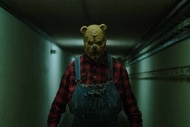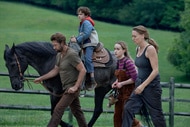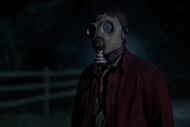Create a free profile to get unlimited access to exclusive videos, sweepstakes, and more!
Emmy Contender: A house changed a major Handmaid's Tale Season 2 moment

Welcome to Emmy Contenders 2019. This month, SYFY WIRE is speaking to a long list of actors, artists, and artisans whose work earned them Emmy nominations this year. Today we speak with Elisabeth Williams, the Emmy-nominated production designer for Hulu's The Handmaid's Tale.
They thought they needed a lake house — a place for the pregnant Offred/June to be stranded and then try to escape by boat. That's what was scripted, at least. But the locations team for The Handmaid's Tale kept striking out in their quest to find a suitable spot for the show's heroine to give birth alone. They needed a magnificent place that would denote wealth and prestige, but it had to be somewhere near the show's production base in Toronto, and with no neighbors in view by day or night. (Foliage might hide neighbors by day, that would be fine; but lights at night couldn't be obscured.)
The team wanted a vintage house in close to its original condition, with no major modern renovations. They also needed a fireplace for the birth scene. And of course, they needed this place to be situated near a lake.
"We looked for that house for many, many weeks," production designer Elisabeth Williams says. "It just didn't exist."
Eventually, the production team was forced to rethink the episode, "Holly," and open up the search to other types of properties. How about a forest house with a detached garage, from which June could try to get away by car? Okay. Soon they found the perfect location, just outside Cambridge, Ontario, half-hidden among forested terrain — an Elizabethan-style manor house on a 966-acre stretch of land called Cruickston Park. (If it looks familiar, that's because it was also featured in RED, Cold Creek Manor, and SYFY's Bitten, where it served as the Stonehaven werewolf sanctuary.)
What really sold the Handmaid's team, though, was a surprise find inside — a 30-foot atrium in the middle of the house, with openings all around each floor. "It was this magical thing," Williams says. "I've never seen that in any house. That was just a total eureka moment."
It meant that someone could stand in the attic, look down to the middle foyer, and eavesdrop on those below. It meant that a planned outdoors scene — the Waterfords fighting outside, June spying on them through a window, deciding whether to shoot — could be transferred inside, a big boon during below-freezing temperatures.
"The writers are in Los Angeles, and we're in Canada, and winter in Canada is a different reality," Williams says. "Sometimes they write a scene where we're like, 'Oh my god. How are we going to do that?' It's just not possible in these conditions." Realizing that they could stage an even better scene and be able to stay warm at the same time was "a gift."
Daina Reid, the director on that episode, "was so excited," Williams recalls. "We were like children in a toy store walking through that house, figuring out the trajectory of which rooms June would go into. And Daina stood in the spaces where Elisabeth Moss would be, where the Waterfords would be, to make sure we had the eyeline."
"It seemed to be the perfect opportunity to really make use of the space in the narrative," the episode's co-writer Kira Snyder says. "It really opened up the possibilities and added to the intensity of the episode, which I describe as a feminist version of The Revenant."
One glitch — as perfect as the house was in terms of its architecture, its interior decorating was not on par with Gilead's standards. The owners enjoyed bright, vibrant colors (yellow, orange, purple), and they also did not want the production to paint the walls of their home, even if they would repaint them back to the original colors after the shoot.
To accommodate their wishes, Williams came up with a Plan B: Build panels that could be fixed to the walls in every room, and paint those. "Then, when we left, we could pull the panels off and leave their color behind," she says. "And in a few places, we did ruin their paint, so we had to paint over that, but we did try very hard not to ruin their walls."
Williams also added wallpaper, changed the window dressings, and brought in new artwork, since Gilead's Commanders had pilfered pieces that belonged in museums. Fortunately, because the location in the story was meant to be a summer home, she was able to cover most furniture with sheets.
"We looked at each room as like an art piece tableau," she says. "We were trying to create a composition with different colors. But because some of it is taking place at nighttime, some of those very beautiful colors are lost in the darkness of the image. It's still mesmerizing to look at, though."
The only thing left to do after all the interior design was to "ruin" something else — the garage door. All June wants to do is drive away, but she can't get the door to open; it's iced up at the bottom. To make sure it couldn't open, Williams modified the door to the three-car garage, adding metal bars as reinforcement. "The real door was actually a flimsy, light wood," Williams says. "A car could make a hole through that — if you stepped on the gas hard enough, no problem."
"That was a little bit of a critique when the episode came out," Snyder recalls. "Some people said, 'Why couldn't she get out of the garage?' And I just had to smile at that."
"It could just be a finicky garage door that is broken!" Snyder says, noting that she did a lot of research into how cold weather can mess with garage doors. "And it's not like June has the mechanical know-how to fix that. She can't look it up on Google."




























